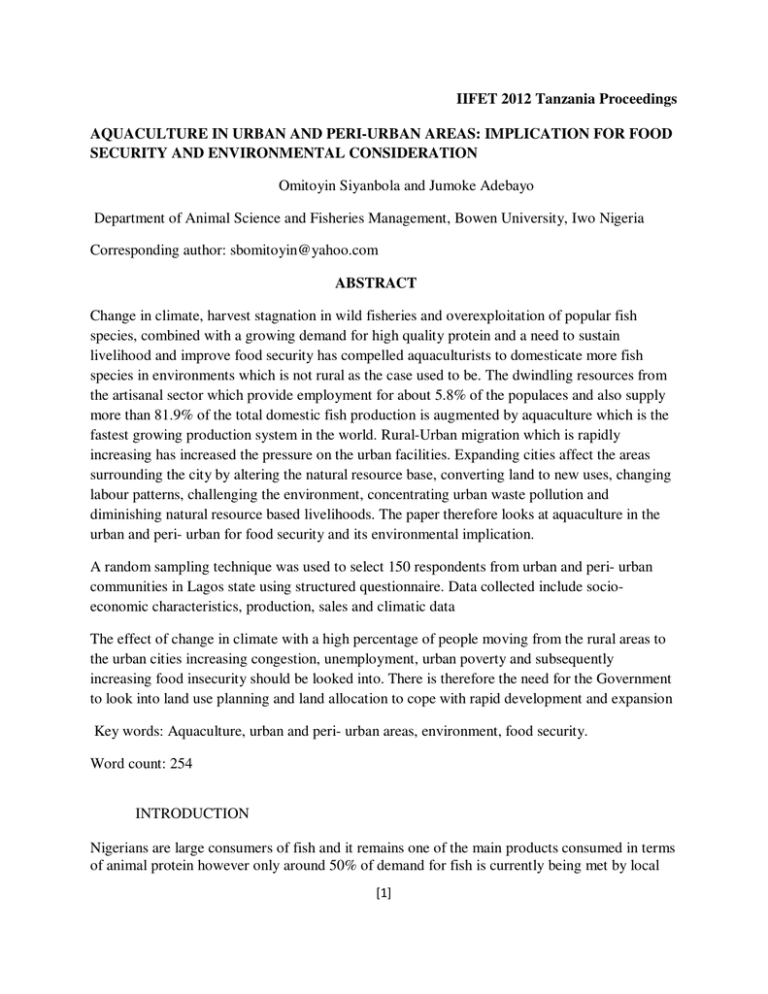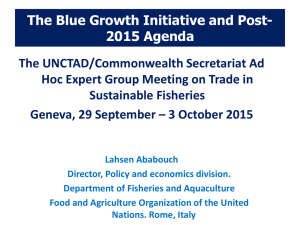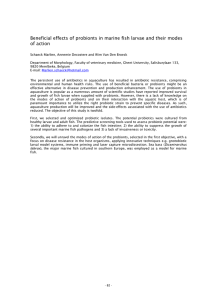IIFET 2012 Tanzania Proceedings SECURITY AND ENVIRONMENTAL CONSIDERATION
advertisement

IIFET 2012 Tanzania Proceedings AQUACULTURE IN URBAN AND PERI-URBAN AREAS: IMPLICATION FOR FOOD SECURITY AND ENVIRONMENTAL CONSIDERATION Omitoyin Siyanbola and Jumoke Adebayo Department of Animal Science and Fisheries Management, Bowen University, Iwo Nigeria Corresponding author: sbomitoyin@yahoo.com ABSTRACT Change in climate, harvest stagnation in wild fisheries and overexploitation of popular fish species, combined with a growing demand for high quality protein and a need to sustain livelihood and improve food security has compelled aquaculturists to domesticate more fish species in environments which is not rural as the case used to be. The dwindling resources from the artisanal sector which provide employment for about 5.8% of the populaces and also supply more than 81.9% of the total domestic fish production is augmented by aquaculture which is the fastest growing production system in the world. Rural-Urban migration which is rapidly increasing has increased the pressure on the urban facilities. Expanding cities affect the areas surrounding the city by altering the natural resource base, converting land to new uses, changing labour patterns, challenging the environment, concentrating urban waste pollution and diminishing natural resource based livelihoods. The paper therefore looks at aquaculture in the urban and peri- urban for food security and its environmental implication. A random sampling technique was used to select 150 respondents from urban and peri- urban communities in Lagos state using structured questionnaire. Data collected include socioeconomic characteristics, production, sales and climatic data The effect of change in climate with a high percentage of people moving from the rural areas to the urban cities increasing congestion, unemployment, urban poverty and subsequently increasing food insecurity should be looked into. There is therefore the need for the Government to look into land use planning and land allocation to cope with rapid development and expansion Key words: Aquaculture, urban and peri- urban areas, environment, food security. Word count: 254 INTRODUCTION Nigerians are large consumers of fish and it remains one of the main products consumed in terms of animal protein however only around 50% of demand for fish is currently being met by local [1] IIFET 2012 Tanzania Proceedings supply. The fisheries sector is estimated to contribute 3.5% of Nigeria‘s GDP and provides direct and indirect employment to over six million people (1). Recent trends all over the world, point to a decline in landing from capture fisheries, an indicator that fish stocks have approached or even exceeded the point of maximum sustainable yield. Aquaculture therefore remains the only viable alternative for increasing fish production in order to meet the protein need of the people. Aquaculture is an important economic activity in many countries Nigeria inclusive and offers opportunities to contribute to poverty alleviation, employment, community development, reduction of exploitation of natural resources, and food security in tropical and subtropical regions. Aquaculture also plays an important role in the livelihoods of many urban dwellers employed as farmers and traders. The development of aquaculture has, however, generated debate over the social and environmental costs and benefits. Viewed alternatively as a solution to overfishing or as a massive threat to marine and freshwater environments, aquaculture has come to the forefront of debates about the long-term viability of global food production systems. However, despite all the fears of its effects on the environment, there is the need for an increase in aquaculture production in order to boost the income of household, increase the level of qualitative and nutritional food intake, provide employment, increase countries GDP and on the overall solve food security which cannot be over emphasized ( 2). With ever increasing population (about 160 million), migration, urbanisation and competition among conflicting projects with scarce resources (Land), Urban and peri- urban aquaculture can help mitigate urban poverty and enhance food security among urban and peri-urban dwellers. Urban aquaculture is defined as the cultivating of fish or food in a confined environment in a city with population clusters of 1000 or more people while Peri-urban aquaculture is defined as the cultivating of fish or food in a controlled environment in an area between the suburbs and the country side. Urban and peri- urban aquaculture varies from the relatively small-scale semi extensive culture system to the high-tech, intensive culture of different types of fish in concrete/plastic tanks (3). Relationship between urban and peri-urban areas fosters economic development of a Nation through income enhancement, increasing productivity, poverty alleviation and employment promotion (4) In Nigeria, about 44% of the population live in towns and cities and urban agriculture including aquaculture contributes in no small measure to their food security. Urban aquaculture has gained importance in Nigeria as a viable intervention strategy for the urban poor (5). The paper therefore is looks at aquaculture in the urban and peri- urban areas of Lagos State for food security and its environmental implication. [2] IIFET 2012 Tanzania Proceedings Methodology The study was carried out in Lagos state in the South Western part of Nigeria. Lagos state is a maritime state with a geographical area of 3577km square. It is bordered in the South by the Atlantic Ocean, in the West by the Republic of Benin and in the East and North by Ogun state and It stretches over 180km along the coast of the Atlantic Ocean Fig 21: Map of Lagos state showing the urban areas (www.google map.com) Fig 22: Map of Lagos state the showing Peri-urban areas (www.googlemap.com) A random sampling technique was used to select 150 respondents from urban and peri- urban communities in Lagos state using structured questionnaire. Only 110 questionnaires were duely filled and returned with urban area having 56 respondents and peri – urban 54 respondents. Data collection took place between October 2011 and March 2012. Fish farmers were identified in the city with the technical assistance of Lagos State Agricultural Development Programs (LSADP) and Fisheries division of the Lagos State Ministry of Agriculture. Data collected include socio-economic characteristics, production, sales and climatic data RESULT AND DISCUSSION The result of the socio-economic parameters shows that a higher number of males (73.2%) were involved in aquaculture than females (26.8%) in urban while in the peri- urban there were 46.3% males and 53.7% females (Fig 1) Figure 2 shows that 75% of people involved in aquaculture in urban areas are married while 77.8% are married in peri-urban areas. The age group 31 – 40 had the highest occurrence in both Urban (53.6%) and peri-urban (35.2%) areas (Fig 3). [3] IIFET 2012 Tanzania Proceedings This coincide with the active and vibrant age group . This age group is closely followed by 51 – 60 age bracket in urban (30.4%) while that of peri-urban areas is 41 -50 (29.6%) Fig 1: Gender Fig 2: Marital Status Fig 3:Age group The tertiary level of education was observed to be predominant in both urban (57.1%) and periurban (57.4%) areas with only 8.9% and 7.4% not having any formal education in both urban and peri- urban areas respectively (Fig 4). This high level of education should facilitate adoption of new technology, easy access to credit and adherence to good management practices. The household size of between 3-8 had the highest occurrence in both urban (88.3%) and peri-urban (81.8%) areas but peri -urban had more households with more than 8 (Fig 5). Fig 4 : Educational status Fig 5: Household size It was observed that the years of experience range between 1-5 years (Fig 6). This shows the relative newness of the production system in the study area. The Yorubas dominate the business in the urban area with 75%, the Ibos, 23.2% and Hausas (1.8% ) while in peri-urban Yorubas were 68,5%, Ibos 29.6% and Hausas 1.9% (Fig 7). This is expected as the study area is located in the South Western part of Nigeria. The observed result is similar to the finding of Omitoyin et al 2009(6) [4] IIFET 2012 Tanzania Proceedings Fig 6: Years of experience Fig 7: Ethnicity Most of the farmers in both urban (66.1%) and peri-urban (61.1%) had trainings in all aspects of fish production. This is closely followed by training in fish farm management (Fig 8). In urban area, 64.3% were full time, 35.7% were part- time fish farmers. Higher number (74%) of the farmers was full time in peri- urban while 24% were part time involved in other activities. Less than2% was on trial (Fig 9). Farming mode 50 40 30 20 10 0 Full time Part time urban Fig 8 : Training received On trial peri- urban Fig 9: Farming mode Most of the farmers in both urban and peri-urban areas used concrete tanks (57.1%/46.3%).This is followed by plastic tanks and then earthen ponds (Fig 10 ) with majority culturing one species of fish (Fig 11) All the farmers in peri urban cultured cat fish with only a few in urban area raising tilapia (Fig 12).The use of concrete tanks may not be unconnected with available land and environmental consideration as it is easier to fill and drain water off the concrete tanks than the earthen ponds. Majority of the farmers in urban (87.5%) and 66.7% in peri – urban areas are table size fish producers (Fig 13). [5] IIFET 2012 Tanzania Proceedings Fig10: Pond type Fig 11: Culture system Fig 12: Cultured species Fig 13: Size cultured The fish seed used are obtained from reputable hatchery, friends and personal breeding (fig 20) Fig 20: Source of fish seed [6] IIFET 2012 Tanzania Proceedings Most farmers in the study area stock there fish quarterly (82.2%) in urban and 61.1% in peri – urban) (Fig 14) and also harvest quarterly (76.8%) in urban and 55.5% in peri-urban) (Fig 15). This may not be unconnected with the required size for processing which is commonly practiced now. Fish is sold mostly as fresh in both urban (98.2%) and peri-urban (94.4%) areas. This will help them complete more cycle and make more money (Fig 16).Imported feed is used by most farmers to start off their fish production so as to boost their growth but finish up with locally compounded feed to reduce cost (Fig 17)Fish farming is the primary occupation of 66.1% of the respondents in urban area and 72.7% in peri-urban areas (Fig18). Other activities engaged in as shown in fig 19 reveals that in the urban areas there are civil servants (10.7%), traders (1.8%), farming 3.6%), artisan (7.1%), skilled labor (1.8%) and private business (8.9%).For peri-urban, the trend is Civil service (7.4%), Trading (5.6%), Farming (3.7%), Artisan (1.9%), Skilled labour (3.7%), Private business (5.6%) The result of the socioeconomic characteristics above (Age, marital status, sex, educational status, stocking & harvesting frequency e.t.c) is similar to the observation of Adeogun et al 2007(3) Fig 14: Frequency of stocking Fig 15: Frequency of harvesting Fig 16: Form of fish sale Fig 17: Type of feed used [7] : IIFET 2012 Tanzania Proceedings Fig 18: Primary occupation Fig 19 : Other primary occupation The major problems encountered include High cost of feed, Conflicts with neighbours as a result of high water discharge / effluent release, Low credit facilities, Low pricing compared with cost of production, dart of extension workers and lack of adequate technical knowhow. This is in support of Delgado et al 2003 ( 7).which stated that aquaculture development has resulted in massive changes in land use, polluted neighboring waters with effluent, and spread disease among fish farms. Also Jac Smit, Joe Nasr and Annu Ratta 2001(8) observed that the health hazards of producing food in urban areas must be recognized when looking at farming systems in the city. Pollution levels of soil, water, air, and wastes tend to be higher in the city than in rural areas. The presence of a large human population that potentially could be affected by its proximity to urban farms is another inherent characteristic. These two factors increase concerns about the potential health effects of farming in the city, and make selection of product and method especially vital in urban areas. Gross Margin Analysis Gross margin analysis was used to estimate the cost and returns of smallholder fish farmer enterprises Gross Margin (GM) = TR-TC Where, TR= Total Revenue, measured by the revenue (Naira) obtained from sale of output [8] IIFET 2012 Tanzania Proceedings GROSS MARGIN ANALYSIS OF AQUACULTURAL PRACTICE URBAN Total Revenue obtained = N 3668727200 from sales of Fry/fingerlings, Juvenile, Small, Medium & Large fish Cost of Production of Urban Aquaculture Since Total Variable Cost (TVC) = Sum of cost of (hired labour, family adult, family children, stock, fish feed, drugs, fertilizer and other expenses) or , measured by the sum of expenses on inputs and labor for fish farming, processing and marketing operations and Total Fixed cost (FC) = Sum of cost of (land, pond construction, technology). Cost of production (TC) = Total Variable Cost (TVC) + Total Fixed Cost (TFC) Cost of production (TC) = N 57254100 Gross Profit Margin Profit = Total Revenue (TR) - Cost of production (TC) N 3668727200 – N 57254100 = N 3,611,473,100 Cost of Production of Aquaculture in Peri Urban Since Total Variable Cost (TVC) = Sum of cost of (hired labour, family adult, family children, stock, fish feed, drugs, fertilizer and other expenses) and Total Fixed cost (FC) = Sum of cost of (land, pond construction, technology). Cost of production (TC) = Total Variable Cost (TVC) + Total Fixed Cost (TFC) Cost of production (TC) = N 13292103 Gross Profit Margin Profit = Total Revenue (TR) - Cost of production (TC) N 457797000 - N 13292103 = N 444504897 The result shows that the fish business in peri-urban areas could be profitable with a profit margin of N 444,504,897. These observations are similar to what was obtained by Stuart W Bunting and Roger Lewins 2006, Adeogun et.al. 2007, Oluwasola, 2008 & Akinyele, 2008 ( 9, 3,4,.5) . Also, [9] IIFET 2012 Tanzania Proceedings Miller and Atanda 2011(2) affirm that the practice of aquaculture is profitable in both urban and peri-urban areas especially when there is an available market. Cofie et al (2007) (10) observed an increase in terms of improved income and nutritional status with use of homestead fish ponds in Akure CONCLUSION It is observed that aquaculture is a profitable venture if properly managed. It is time aquaculture is viewed as a business not only as a developmental tool. Efficient utilization of the available resources should be enhanced as Investment in urban and peri-urban with proper management will yield good result, also, effluent discharge should be monitored, treated and recycled to avoid load of waste materials on the environment. Urban planners and local governments should consider how to incorporate environmentally sound urban aquaculture in their plans and bye laws. REFERENCES (1) Adeolu, B. A and A. Taiwo (2004) The Impact of National Fadama Facility in Alleviating Rural Poverty and Enhancing Agricultural Development in South-Western Nigeria J. Soc.Sci, 9 (3): 157 -161 (2) Miller, James W and Tunde Atanda (2011) The rise of peri-urban aquaculture in Nigeria. International Journal of Agricultural Sustainability, Sustainable intensification: increasing productivity in African food and agricultural systems, pp. 274-281(8) DOI: http://dx.doi.org/10.3763/ijas.2010.0569 (3) Adeogun O. A, H.K. Ogunbadejo, O.A. Ayinla, A. Oresegun .O.R. Oguntade, Alhaji Tanko and S.B. Williams (2007 ) Urban Aquaculture: Producer Perceptions and Practices in Lagos State, Nigeria Middle-East Journal of Scientific Research 2 (1): 21-27, 2007 ISSN 1990-9233 IDOSI Publications, 2007 (4) Oluwasola O.I, Idowu, E. O.I and Osuntogun D.A (2008) Increasing agricultural household incomes through rural-urban linkages in Nigeria African Journal of Agricultural Research Vol. 3 (8), pp. 566-573, August 2008 Available online http://www.academicjournals.org/AJAR ISSN 1991-637X © 2008 Academic Journals [10] at IIFET 2012 Tanzania Proceedings (5) Akinyele Isaac O (2008) Food Insecurity and Malnutrition in Rural Areas of Nigeria. Nigeria Aquaculture Policy Support Facility (APSF) International Food Policy Research Institute Maitama Abuja (6) Omitoyin S.A. and B.T Fregene (2009): Effect of Micro-credit on sustainable livelihood of artisanal fisherfolks in Lagos lagoon Nigeria. African Journal of Livestock Extension 7:70-76 (7) Delgado Christopher L, Nikolas Wada, Mark W. Rosegrant, Siet Meijer, Mahfuzuddin Ahmed (2003) Outlook for Fish to 2020, Meeting Global Demand. A 2020 Vision for Food, Agriculture, and the Environment Initiative International Food Policy Research Institute Washington, D.C., U.S.A WorldFish Center, Penang, Malaysia (8) Smit Jac , Joe Nasr and Annu Ratta (2001) Urban Agriculture: Food Jobs and Sustainable Cities 2001 Edition Chapter 5 Producing Food and Fuel in Urban Areas . Published by: The Urban Agriculture Network, Inc A Non-Profit, 501 (c) (3) Organization with the financial support and permission of the United Nations Development Programme (UNDP) (9) Bunting, S.W. and Lewins, R (2006) Urban and peri-urban aquaculture development in Bangladesh and West Bengal, India. Centre for Environment and Society Occasional Paper 2006-2. University of Essex, UK. (10) Cofie Olufunke, Ajibefun Igbekele and Theophilus Larbi (2007) Promoting Homestead Fish Culture through a Participatory Approach in Akure, Ondo State, Resource Centres on Urban Agriculture and Food Security [11] Nigeria RUAF





